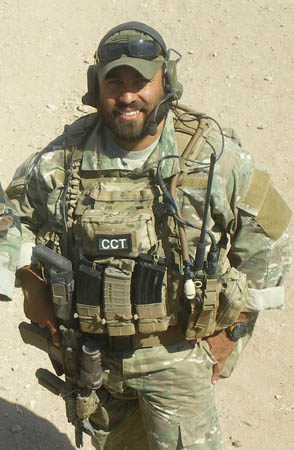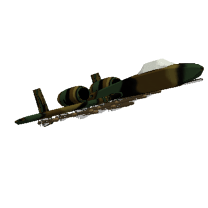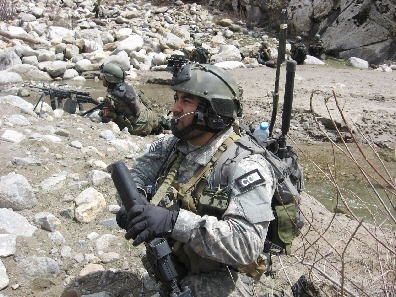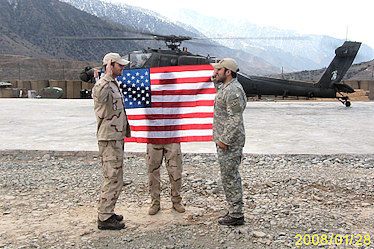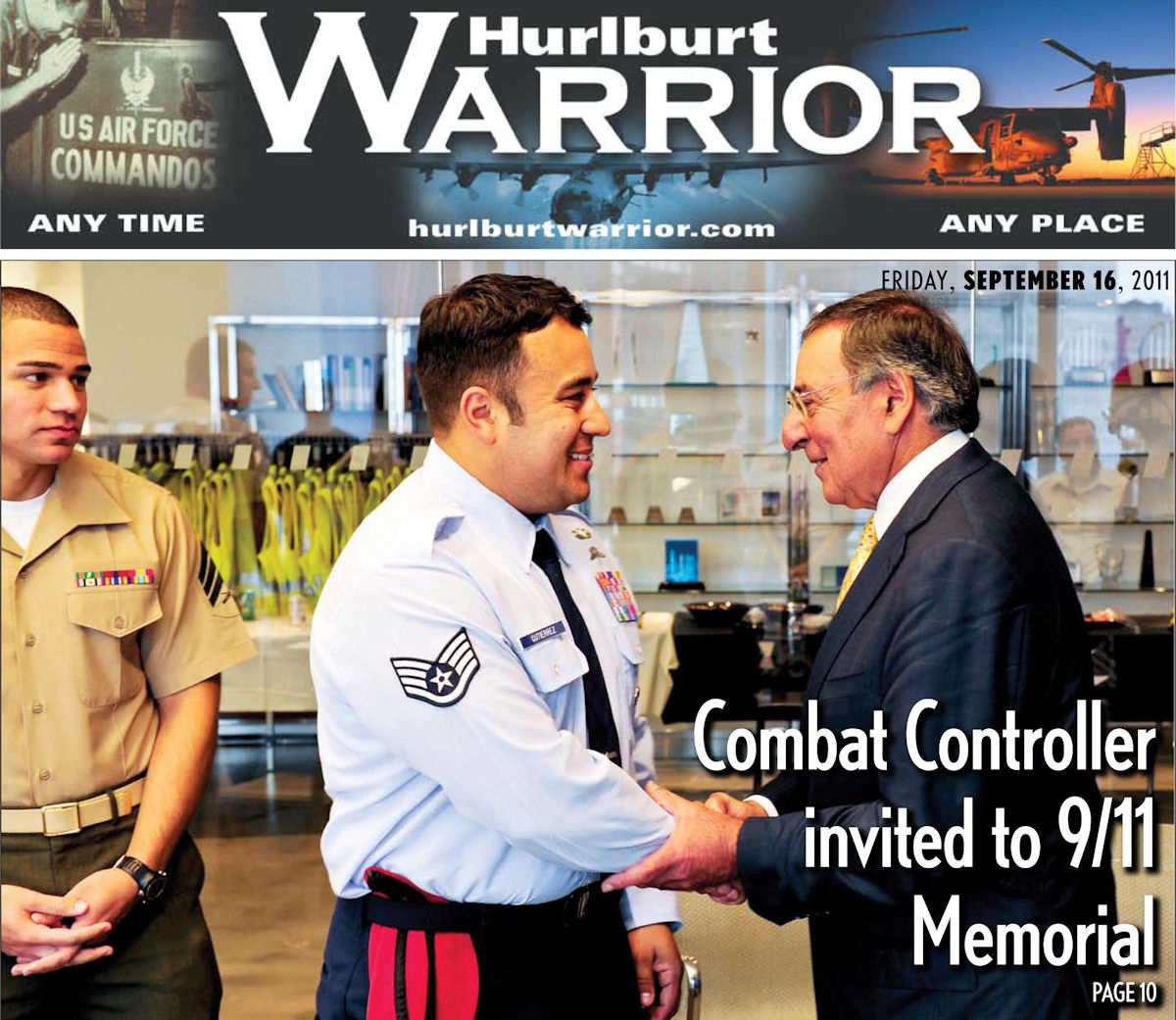 EDITOR'S
NOTE: Air Force Special Operations Command Combat Controller, Staff
Sgt. Robert Gutierrez Jr., was invited to join the Secretary of Defense
during a 9/11 remembrance tour in New York. Gutierrez enlisted in 2002
following graduation from Southwestern Community College. He deployed
to Africa in support of Marine and Navy special operations elements,
and twice to Afghanistan, where he was responsible for directing
airstrikes in support of Army Special Forces. Gutierrez received the
Bronze Star Medal with Valor and was selected as one of the Air Force's
12 Outstanding Airmen of the Year in 2010. He was wounded by enemy fire
on his second deployment. He is from Chula Vista, Calif, and currently
is an instructor assigned to the Air Force Special Operations Training
Center.
Gutierrez told reporters the visit to ground zero "reminded me why I enlisted." Gutierrez said he tried to enlist the day after the attacks, but the recruiting stations were dosed. When they reopened, a waiting list quickly formed because of the rush of people wanting to sign up for the military, he said, and his own enlistment was final about six months after the attacks. America's greatest strength is highlighted by its service members, Panetta said. And the young people in uniform traveling with him today, he added, represent the service they and their fellow soldiers, sailors, airmen, Marines and Coast Guardsmen have given to the nation. "Since 9/11, we have achieved significant success going after al-Qaida and... Bts] leadership," Panetta said, adding that, nevertheless, it's critical to maintain pressure on the terrorist organization.
RANDOLPH
AIR FORCE BASE, Texas, (8/3/10) -- Air Force officials selected the 12
Outstanding Airmen of the Year for 2010.
An Air Force selection board at the Air Force Personnel Center here considered 36 nominees who represented major commands, direct reporting units, field operating agencies and the Air Staff. The board selected the 12 Airmen based on superior leadership, job performance and personal achievements. The nominees are authorized to wear the Outstanding Airman of the Year ribbon, while the 12 winners will wear the bronze service star device on the ribbon. The winners will also wear the Outstanding Airman of the Year Badge for one year from the date of formal presentation.
His
ODA team crossed the bridge by foot to check houses in the compound,
and once again came under intense enemy fire - this time from three
sides of their position.
Cut off from the heavy weapons in their convoy and pinned down by insurgent fire, the situation grew worse with each passing moment. The team leader was incapacitated within minutes and another team member was wounded and stranded in the enemy "kill zone." With the enemy pressing for advantage, Sergeant Gutierrez went to work. He directly engaged and killed four insurgents with his M-4 Carbine and orchestrated eight strafing runs from A-10 aircraft onto multiple targets threatening to overrun their location. The A-10 passes gave him and a team member the opportunity to run in and out of the "kill box" to retrieve their critically wounded teammate. Consolidating the team's position, Sergeant Gutierrez then directed more than 70 close air support strikes over the next five plus hours while repelling numerous attempts by insurgents to overrun their position. His focus and technical battlefield expertise were deciding factors to the team's survival - a fact born out by the operation's final numbers. "I determined the enemy's positions as fast as I could," he said. As he continuously directed A-10 Thunderbolts, F-15 Strike Eagles and AH-64 Apache helicopters onto multiple targets surrounding their position, often with the enemy just meters away. Afterward, he used both A-10s and UAVs, to keep the enemy at bay and gain information on enemy positions, maintaining a protective fire suppression blanket for his team from the air.
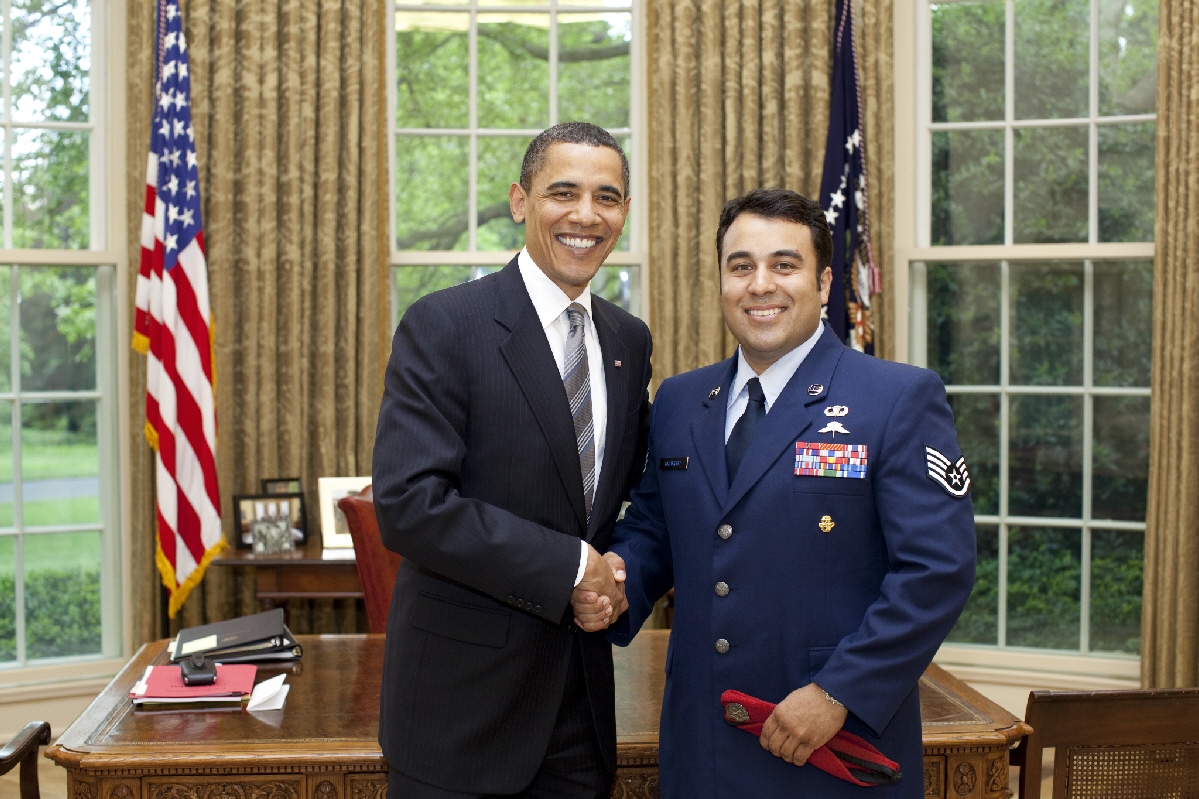 Mr.
President, as I mentioned
earlier, it was our privilege to honor these heroic Green Berets, who
were joined at the lunch by SSG Robert Gutierrez, Jr., an Air Force
special tactics Combat Controller who targeted airstrikes during the
mission. For his actions, he was awarded the Bronze Star Medal with
``V'' device for valor, a Purple Heart, and an Air Force
Combat Action Medal. Mr.
President, as I mentioned
earlier, it was our privilege to honor these heroic Green Berets, who
were joined at the lunch by SSG Robert Gutierrez, Jr., an Air Force
special tactics Combat Controller who targeted airstrikes during the
mission. For his actions, he was awarded the Bronze Star Medal with
``V'' device for valor, a Purple Heart, and an Air Force
Combat Action Medal.
Sergeant
Gutierrez earned the medals for two separate deployments to
Afghanistan. His Bronze Star Medal was awarded for his actions under
intense enemy fire in Afghanistan winter 2008. His Purple Heart was
awarded for injuries sustained in late 2009.
10 Green Berets To Receive Silver Star for Afghan Battle After jumping out of helicopters at daybreak onto jagged, ice-covered rocks and into water at an altitude of 10,000 feet, the 12-man Special Forces team scrambled up the steep mountainside toward its target--an insurgent stronghold in northeast Afghanistan. ``Our plan,'' Capt. Kyle M. Walton recalled in an interview, ``was to fight downhill.'' But as the soldiers maneuvered toward a cluster of thick-walled mud buildings constructed layer upon layer about 1,000 feet farther up the mountain, insurgents quickly manned fighting positions, readying a barrage of fire for the exposed Green Berets. A harrowing, nearly seven-hour battle unfolded on that mountainside in Afghanistan's Nuristan province on April 6, as Walton, his team and a few dozen Afghan commandos they had trained took fire from all directions. Outnumbered, the Green Berets fought on even after half of them were wounded--four critically--and managed to subdue an estimated 150 to 200 insurgents, according to interviews with several team members and official citations. Today, Walton and nine of his teammates from Operational Detachment Alpha 3336 of the 3rd Special Forces Group will receive the Silver Star for their heroism in that battle--the highest number of such awards given to the elite troops for a single engagement since the Vietnam War. That chilly morning, Walton's mind was on his team's mission: to capture or kill several members of the Hezb-e-Islami Gulbuddin (HIG) militant group in their stronghold, a village perched in Nuristan's Shok Valley that was accessible only by pack mule and so remote that Walton said he believed that no U.S. troops, or Soviet ones before them, had ever been there. But as the soldiers, each carrying 60 to 80 pounds of gear, scaled the mountain, they could already spot insurgents running to and fro, they said. As the soldiers drew closer, they saw that many of the mud buildings had holes in the foot-thick walls for snipers. The U.S. troops had maintained an element of surprise until their helicopters turned into the valley, but by now the insurgent leaders entrenched above knew they were the targets, and had alerted their fighters to rally. Staff Sgt. Luis Morales of Fredericksburg was the first to see an armed insurgent and opened fire, killing him. But at that moment, the insurgents began blasting away at the American and Afghan troops with machine guns, sniper rifles and rocket-propelled grenades--shooting down on each of the U.S. positions from virtually all sides. ``All elements were pinned down from extremely heavy fire from the get-go,'' Walton said. ``It was a coordinated attack.'' The insurgent Afghan fighters knew there was only one route up the valley and ``were able to wait until we were in the most vulnerable position to initiate the ambush,'' said Staff Sgt. Seth E. Howard, the team weapons sergeant. Almost immediately, exposed U.S. and Afghan troops were hit. An Afghan interpreter was killed, and Staff Sgt. Dillon Behr was shot in the hip. ``We were pretty much in the open, there were no trees to hide behind,'' said Morales, who with Walton pulled Behr back to their position. Morales cut open Behr's fatigues and applied pressure to his bleeding hip, even though Morales himself had been shot in the right thigh. A minute later, Morales was hit again, in the ankle, leaving him struggling to treat himself and his comrade, he said. Absent any cover, Walton moved the body of the dead Afghan interpreter to shield the wounded. Farther down the hill in the streambed, Master Sgt. Scott Ford, the team sergeant, was firing an M203 grenade launcher at the fighting positions, he recalled. An Afghan commando fired rocket-propelled grenades at the windows from which they were taking fire, while Howard shot rounds from a rocket launcher and recoilless rifle. Ford, of Athens, Ohio, then moved up the mountain amid withering fire to aid Walton at his command position. The ferocity of the attack surprised him, as rounds ricocheted nearby every time he stuck his head out from behind a rock. ``Typically they run out of ammo or start to manage their ammo, but ..... they held a sustained rate of fire for about six hours,'' he said. As Ford and Staff Sgt. John Wayne Walding returned fire, Walding was hit below his right knee. Ford turned and saw that the bullet ``basically amputated his right leg right there on the battlefield.'' Walding, of Groesbeck, Tex., recalled: ``I literally grabbed my boot and put it in my crotch, then got the boot laces and tied it to my thigh, so it would not flop around. There was about two inches of meat holding my leg on.'' He put on a tourniquet, watching the blood flow out the stump to see when it was tight enough. Then Walding tried to inject himself with morphine but accidentally used the wrong tip of the syringe and put the needle in his thumb, he later recalled. ``My thumb felt great,'' he said wryly, noting that throughout the incident he never lost consciousness. ``My name is John Wayne,'' he said. Soon afterward, a round hit Ford in the chest, knocking him back but not penetrating his body armor. A minute later, another bullet went through his left arm and shoulder, hitting the helmet of the medic, Staff Sgt. Ronald J. Shurer, who was behind him treating Behr. An insurgent sniper was zeroing in on them. Bleeding heavily from the arm, Ford put together a plan to begin removing the wounded, knowing they could hold out only for so long without being overrun. By this time, Air Force jets had begun dropping dozens of munitions on enemy positions precariously close to the Green Berets, including 2,000-pound bombs that fell within 350 yards. ``I was completely covered in a cloud of black smoke from the explosion,'' said Howard, and Behr was wounded in the intestine by a piece of shrapnel. The evacuation plan, Ford said, was that ``every time they dropped another bomb, we would move down another terrace until we basically leapfrogged down the mountain.'' Ford was able to move to lower ground after one bomb hit, but insurgent fire rained down again, pinning the soldiers left behind. ``If we went that way, we would have all died,'' said Howard, who was hiding behind 12-inch-high rocks with bullets bouncing off about every 10 seconds. Insurgents again nearly overran the U.S. position, firing down from 25 yards away--so near that the Americans said they could hear their voices. Another 2,000-pound bomb dropped ``danger close,'' Howard said, allowing the soldiers to get away. Finally, after hours of fighting, the troops made their way down to the streambed, with those who could still walk carrying the wounded. A medical evacuation helicopter flew in, but the rotors were immediately hit by bullets, so the pilot hovered just long enough to allow the in-flight medic to jump off, then flew away. A second helicopter came in but had to land in the middle of the icy, fast-moving stream. ``It took two to three guys to carry each casualty through the river,'' Ford said. ``It was a mad dash to the medevac.'' As they sat on the helicopter, it sustained several rounds of fire, and the pilot was grazed by a bullet. By the time the battle ended, the Green Berets and the commandos had suffered 15 wounded and two killed, both Afghans, while an estimated 150 to 200 insurgents were dead, according to an official Army account of the battle. The Special Forces soldiers had nearly run out of ammunition, with each having one to two magazines left, Ford said. ``We should not have lived,'' said Walding, reflecting on the battle in a phone interview from Fort Bragg, N.C., where he and the nine others are to receive the Silver Stars today. Nine more Green Berets from the 3rd Special Forces Group will also receive Silver Stars for other battles. About 200 U.S. troops serving in Iraq and Afghanistan have received the Silver Star, the U.S. military's third-highest combat award.
12/25/2008
- HURLBURT FIELD, Fla. (AFNS) -- An Air Force Special
Operations
Command Airman saved lives in Afghanistan April 6 during a lengthy
battle by calling in airstrikes to protect his team.
Staff Sgt. Zachary Rhyner, a special tactics Combat Controller assigned to the 21st Special Tactics Squadron at Pope Air Force Base, N.C., was deployed to Operation Enduring Freedom as the primary joint terminal attack controller while attached to special forces team Operational Detachment Alpha 3336, 3rd Special Forces Group. Then a senior airman, Sergeant Rhyner was part of a 130-man combined assault force whose mission was to enter Shok Valley and capture a high-value target who was funding the insurgency. Sergeant Rhyner is credited with saving his10-man team from being overrun twice in a 6.5-hour battle. Capt. Stewart Parker, the detachment commander at Bagram Airfield, Afghanistan, was the command and control link to the JTACs on the ground as they went into Shok Valley. "This was the first time U.S. special operations forces entered the territory," Captain Parker said. "These were extraordinary conditions and the situation was dynamic." Shok Valley is located below 60-foot cliffs. The mission objective was at the top of the mountains surrounding the valley. "Initial infiltration began that day with snow on the ground, jagged rocks, a fast-moving river and a cliff," Sergeant Rhyner said. "There was a 5-foot wall you had to pull yourself up. The ridgeline trail was out of control." The expectation was to encounter fire from about 70 insurgents. One Air Force JTAC-qualified Combat Controller was attached to each team to call in airstrikes, if needed. "We were caught off guard as 200 enemy fighters approached," said Staff Sgt. Rob Gutierrez, a Combat Controller with the second team in the fight. "Within 10 minutes, we were ambushed with heavy fire from 50 meters. The teams were split by a river 100 to 200 meters apart, north to south." Sergeant Rhyner was in charge of coordinating the air assets. "I have never seen a situation this bad," said Captain Parker, who was monitoring the situation back at the base. "The intel said the enemy was 40 feet away from Zach and his team at one point. It was dangerous." Within the first 15 minutes of fire, Sergeant Rhyner was wounded along with three team members. "I was pulling security when I got shot in the leg," he said. "The rounds hit my left thigh and went through my leg and hit another guy in the foot." Sergeant Rhyner said he immediately felt pain and adrenalin. "There was nowhere to go. I grabbed the wounded guys, but we were trapped by the enemy," he said. "I was calling in airstrikes and firing, while moving the wounded down (the cliff)." Sergeant Gutierrez said he could see insurgent fire coming from the buildings on the hilltops above them and was trying to get across the river to meet up with Sergeant Rhyner. "Zach and I were in constant radio contact," he said. "I could hear the ammunition, sniper fire and rocket-propelled grenades with multiple blasts. We tried to push to the north to collocate with Zach's team, but every time we pushed up river, it put us in an open line of fire." "My team ran across the freezing river. The water came off the mountains, and we were 100 to 200 feet beneath the enemy, like fish in a barrel," Sergeant Gutierrez said. As the enemy surrounded them, Sergeant Rhyner, who was being treated for his injuries by Capt. Kyle Walton, the special forces team leader, directed multiple rockets and gun runs from AH-64 Apache helicopters against enemy positions. "Zach was coordinating tremendous amounts of fire on both villages simultaneously," Sergeant Gutierrez said. "Zach was in charge of the airstrikes, since he was closest to the fight and could see even what the F-15 (Eagle) pilots could not." Forty-five minutes to an hour had gone by since the fight began. "We were pinned down and I could see the enemy all over the hills running around," Sergeant Gutierrez said. There were no stable targets. I kept the Apaches and the Hellfire missiles pressed to the north." Accurate sniper, machine gun and
RPG fire poured down on the assault
force in a complex ambush initiated simultaneously from all directions
as Alpha Team 3336 ascended the near-vertical terrain. He called in
more than 50 close airstrikes and strafing runs.
Three hours into the fight, Sergeant Gutierrez reached Sergeant Rhyner's position. "Sergeant Gutierrez and I met on the cliff during the battle briefly. We shared a laugh, but it was a busy, bleak situation," Sergeant Rhyner said. Sergeant Rhyner had been calling in airstrikes for three hours while he was injured; however, he still felt responsible for the others who had been hurt. With disregard for his own life, he tried to get the injured to safety, still in the open line of fire. "I left injured personnel in a house and I had to get over there," he said. "I was frustrated being wounded. I tried to get the bombs there fast and talk to the pilots who didn't see what I saw on the ground." Five or six hours into the fight, as it was getting dark, intelligence informed the JTACs that enemy reinforcements were 10 kilometers away carrying enemy rockets and missiles. "We continued to fight our way up the hill and the (helicopters) came," Sergeant Gutierrez said. "Zach was talking to the helos and gave the coordinates to lay the bombs on the village, while I kept the A-10 (Thunderbolt IIs) and the Apaches out of the way." Sergeant Rhyner called in a total of 4,570 rounds of cannon fire, nine Hellfire missiles, 162 rockets, 12 500-pound bombs and one 2,000-pound bomb, constantly engaging the enemy with his M-4 rifle to deter their advance. "Zach acted fast and shut down the fighting," Sergeant Gutierrez said. "The wounded were taken out on medevac." Back at command and control, Captain Parker heard that the helicopters were on the ground with the wounded but he could not move the helicopters due to the terrain and weather conditions. "Radio transmissions would block the signal due to terrain and vertical cliffs," he said. "Helicopters were vulnerable and there was pressure to do everything we could to get the teams out quickly." Fog then started rolling into the valley. "At 8,000 feet, the helicopter couldn't fly (due to altitude) and the situation called for 'aggressive patience,'" Captain Parker said. "More than 50 percent of the U.S. forces were wounded, and it was pretty grave." Toward the end of the fighting, 40 insurgents were killed and 100 wounded Sergeant Rhyner was directly credited with the entire team's survival due to his skill and poise under intense fire. "Sergeant Rhyner is out of training less than a year and is in one of the most difficult situations," Captain Parker said. "It is an absolute testament to his character and the training these guys take. It tells me we are doing something right." "If it wasn't for Zach, I wouldn't be here," Sergeant Gutierrez said. An Airman’s Tale; He was shorter than I expected. Rounder, too. In most of the photos I’d seen he’d worn the downrange beard, thick as otter fur, that marks a Special Operator. It lent him a kind of Santa Claus’s badass nephew mien. But when I met him last week at Hurlburt Field, home to the USAF’s Special Operations Command, he was clean-shaven, with a ready smile and a jaunt to his gait that belied the wounds he bore. For your consideration: the tale of Staff Sergeant Robert Gutierrez Jr., Forward Combat Controller extraordinaire. It was October, 2009. Early October. Herat Province, Afghanistan. Gutierrez was attached to a team of 30 Army Special Forces and Afghan National Army commandos tracking what the Pentagon refers to as “high-priority targets.” (Most warfighters in the field just go with “bad mofos.”) The combined team had entered a nondescript village where the target was said to be hiding. All hell broke loose. Ambush. They were waiting for them. For over four hours rifle and RPG fire from the adjacent rooftops ripped into the American position. Surrounded, outgunned, and outmanned, Guterrez emptied clip after clip of his M4 carbine. Then he felt the sting. Armor piercing round. It entered through his left shoulder and corkscrewed into his torso, lodging finally in his chest after breaking two ribs and his scapula. His lungs collapsed, and he was bleeding out from a softball-sized hole in his back. “I’ve seen those types of injuries,” he said. “Time isn’t your friend. I thought, ‘I have three minutes before I’m going to die.’” This posed a problem not only for Gutierrez, but for the entire SF Team. For “The Goot” was the only radio operator in communication with the F-16s and A-10s vectoring overhead on strafing and bombing runs. Yet despite believing he was about to die, Gutierrez refused to allow the two Army medics to remove his kit and armor in order to treat him. His radio, you see, was attached to his kit. And without Gutierrez on the hand-held, the gunships providing close air support would have no “eyes on the ground.” One of the A-10 pilots remembers Gutierrez’s voice throughout the ordeal, calm and cool as an FM deejay’s. It was only after returning to base that the pilot learned that the Combat Controller had been delivering coordinates and instructions as the life oozed out of him. After the third strafing run, after the air power had decimated the insurgents to the point where the Army SF Team could make a run for it, Gutierrez finally allowed the medics to remove his battle rattle and insert a needle-nosed decompression tube into his lungs. Then he put the armor back on and continued calling in fire. When it came time to Di Di Mau (showing my age), Gutierrez, the tube still planted in his chest, ran about a mile with the rest of the team to the exfil LZ. Along the way he continued to guide the gunships as well as call in his own medevac. Gutierrez obviously lived. From Walter Reed Hospital he transferred to Hurlburt, where he is still recuperating. Which is where I found him last week, attending a small graduation ceremony for another generation of Combat Controllers. He doesn’t like to talk much about the firefight. “Tell you the truth, I really don’t remember all that much about it,” he said. “Except for, at one point, thinking. ‘Okay, I’m gonna die. But unless I stay on this radio we’re all gonna die, not just me. And I’m not gonna let that happen.’ Plus, my wife was pregnant with our first at the time, and I was sad that I’d never get to see my baby.” Gutierrez was there when his wife gave birth to a girl that December. The couple has since added a baby brother to the brood. And as we compared notes on our kids I thought once again of the wonder of ordinary men thrust into extraordinary circumstances. For his valor and courage Gutierrez was awarded the Air Force Cross, the service’s highest honor and the country second-highest military award, second only to the Congressional Medal of Honor. Gutierrez and I made more small talk for while before shaking hands goodbye. I lingered to watch him walk out the door into the bright Florida sunlight, don his Combat Controller’s scarlet beret, and head for another round of physical therapy. He was still shorter than I expected. Rounder, too. My 14-year-old was in Stateside from Europe for the Holidays. Tells me when he grows up he wants to be a diplomat. (Of all things! What ever happened to a fireman or a cowboy?) Yet on one of our long, see-the-Mercun-cousins road trips my son and I got to talking about military service. He asked me if, should he go in that direction, which Special Forces would I recommend. Air Force, I answered without hesitation. They’ve got the coolest berets. |
|||||||||||||||||
